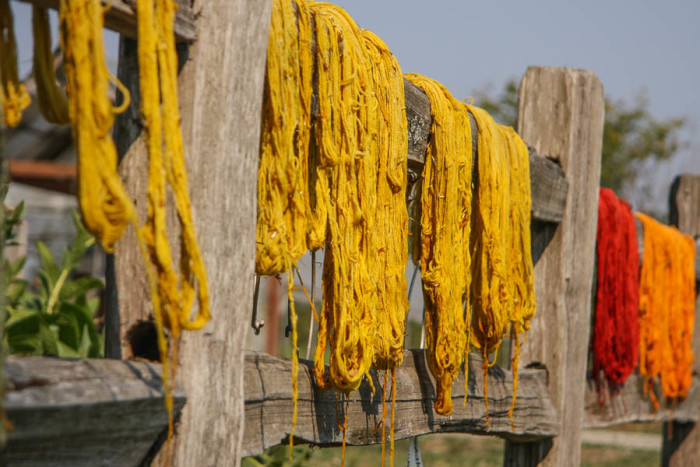
Your soft cotton tee shirt is the ultimate warm fuzzy. Snuggling gratefully into its soft fibers, you feel virtuous about buying a product that was made of natural organic materials. Think of all those barrels of pesticides and synthetic fertilizers that weren’t sprayed on foreign cotton fields thanks to you. Think of the smiling cotton farmers in Turkey and India growing those pure white organic tufts for you to snuggle into.
Sigh.
Bet you a tidy sum that the label boasting of organic fiber on that shirt says nothing about the luscious color. And for good reason.
We tend to be blissfully unaware of the myriad health problems attributed to the textile dyeing process, as most of our clothing is not from around here.
Yet somewhere in India, a river runs fluorescent pink. Or electric blue, or tangerine orange.
Perhaps the most infamous of these is India’s Noyyal River, which carries toxin-dense waste water from factories in Tirupur — a metropolis also known as “Knit City.” The effluent resulting from dyeing that imported cotton shirt you love pours from the dyeing plant into the Noyyal and other Indian and Chinese streams and rivers, carrying with it toxic chemicals – cancer-causing cadmium, lead, chromium, mercury, and more.
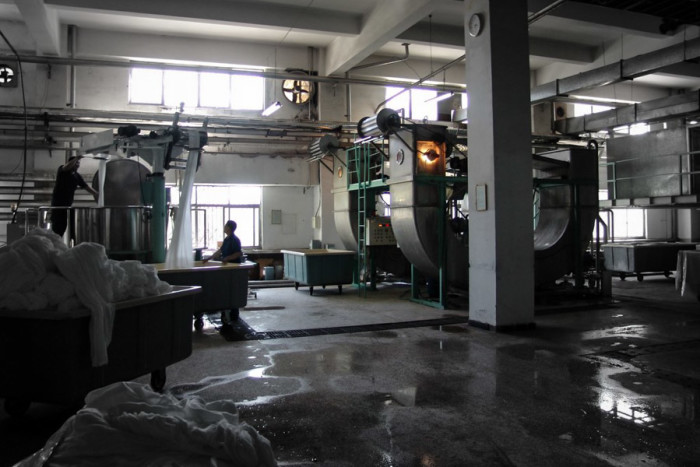
But one Seattle woman believes that we don’t have to pay such a heavy price for our penchant for color, and she is sharing her passion for plant-based, low-water dyes, adding to a “slow clothing” movement.
On a sunny recent August afternoon, Kathy Hattori leads a small band of acolytes to the cutting flower garden on Jubilee Farm, an organic CSA (Community Supported Agriculture) grower in Washington state’s fertile Snoqualmie valley.
She stops in front of a backdrop of enormous sunflowers and faces her students from behind a row of blanket-flowers, a daisy-like bloom glowing with streaks of orange, gold, pink, and coral. “Gaillardia,” she pronounces. “Let’s cut these – we should get some good color.”
The gloved throng bends to gather the bright flower heads, filling baskets.
Despite the jeans and encyclopedic knowledge of plant-based dyes, Hattori’s past career was rooted not in textiles or art but in the corporate world.
“The specter of Death drove me from the high-tech world,” she joked in an earlier interview.
A degree in environmental studies originally led to a job with the EPA. Her administrative flair led to a highly-paid but draining stint in the Silicon Valley. But discontent with the unfulfilling work led her to establish a new life in Seattle.
Leveraging her business background and following a long-time love of textiles, Hattori went to work for a natural dye company. There she became aware of the toxicity bedeviling conventional clothing. It was the 2005 GreenPeace report, “Toxic Threads” that galvanized her explorations with natural dyes.
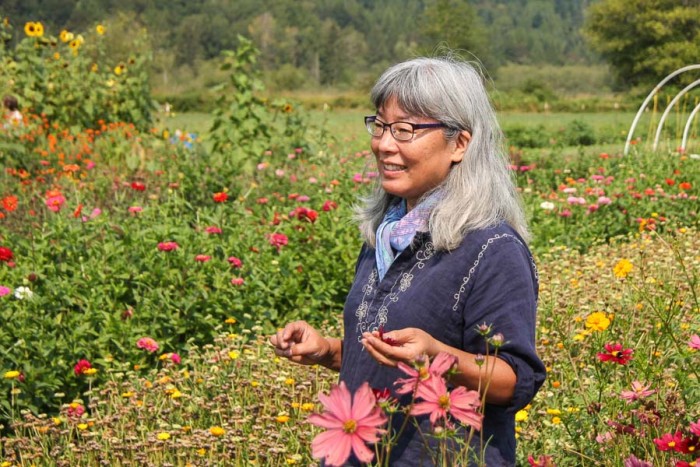
She learned about places like “Knit City,” where about a third of nearby villagers find themselves suffering from a range of ailments attributed to dye-related pollution, including gastritis, joint pain, and more.
Azo dyes, which are used for about 70% of textiles made, carry significant health and cancer risk, as do other chemicals used in the process like benzidine, pthalates, and formaldehyde.
Large amounts of precious potable water in clothing producing countries like China, India, and Bangladesh, is diverted from human and animal use, to be used in the dyeing process and then released back into streams. Neighboring farmland can be rendered unusable, exacting a heavy toll on health, livelihoods, and the environment.
The clothing produced arrives in the shopping bags of first world consumers with toxic residue, continuing the threat of toxic run-off to our own local water supplies. This is particularly concerning with regard to children’s clothing.
“I’d known that there were some pretty aggressive chemicals in the textile dyeing industry,” Hattori said. “But I didn’t realize just how toxic the substances are, and I hadn’t known about the amount of effluent produced and the enormous amount of water used in these processes. It had a huge effect on me.”
In 2010, she formed her own company, Botanical Colors, producing natural dyes for hobbyists and eventually for the fashion industry.
“I now work with small designers,” Hattori told me. “Younger designers are frustrated by not being able to make sustainable designs.”
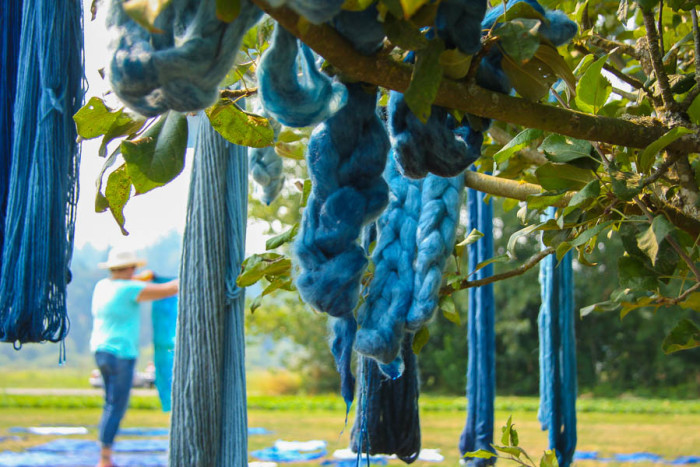
To that end, Hattori collaborates with New York design house Eileen Fisher, overdyeing gently-used clothing for Eileen Fisher’s clothing recycling initiative, Green Eileen.
Re-sellers like Green Eileen address a related concern of Hattori’s: the impact of the enormous amount of clothing we purchase in the developed world — as much as 70 pieces of clothing per person per year, by some estimates.
Producing dyes in bulk is a part of Hattori’s commitment to sustainability.
“National brands find it difficult to adapt to using natural dyes, but many of them have committed to fix their supply chains by 2020. I want to figure out how to bring the process to the point where it is practical for them to use; to be an evangelist,” she said as we sat in her Ballard facility. “If I can get their attention and then their buy-in, we can start to make a change. But natural dyes are challenging to mass-produce. You never eat the same piece of spinach twice, and it’s that way with natural dyes.”
But by accumulating large quantities over a season, maintaining disciplined procedures, and exercising her artistry – assessing and modifying the color as her eye tells her – Hattori is succeeding. Well-known Dharma Trading Company, a California-based fiber art supply company, now uses Hattori as one of their suppliers.
Even so, Hattori keeps what she calls “a visceral attraction to the work of the hand” at top of mind, accepting teaching requests in an ever-wider geographical range. That is how we find ourselves in that idyllic field, dipping organic and locally-raised wool into pots of water infused with color from blanket flowers, marigolds, and cochineal insects. Blouses, wool skeins, and even canvas shoes find their way into vats of indigo. As we lift out skeins of wool, now glowing with intense yellows, oranges, reds, and delicate green, depending on the ingredient, I ask Michael Fromberger, a Google programmer, what has drawn him to this decidedly low-tech pastime.
“I think that through human history, we’ve been surrounded by plants and used them in all kinds of ways. Now we seem aware of only a small number, and we think of them only as food,” he muses. “What I enjoy about this is that it reminds me that we’re not so alien from the natural world, and I love having this skill.”
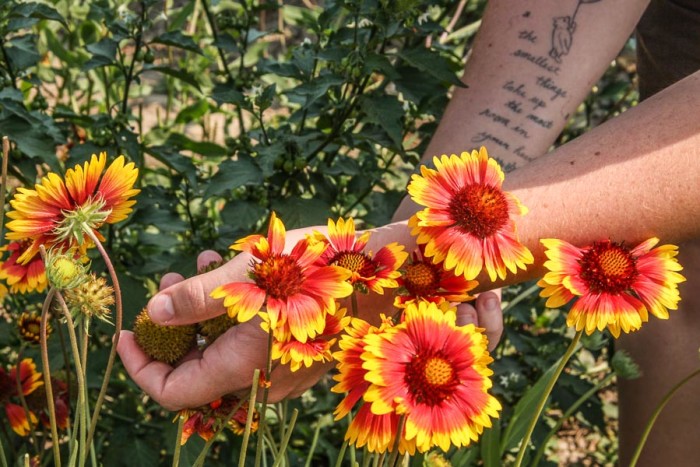
Melissa Bob, an artist of Coast Salish heritage who has also joined the class, wanted to learn the methods her ancestors used to create their distinctive textiles and adapt them to her own work. Beth Murphy, herself a knitwear designer, and Jade Getz, an artist and photographer, are interested in sustainable clothing and art. Enthusiasts of the Fiber Shed movement, which is dedicated to locally and sustainably-produced clothing, they were keen to expand their skills to produce and enhance fibers for their art and their clothing. Several participants likened the growing movement to the organic food crusade of a generation ago.
Anna Dianich, owner of Tolt Yarn and Wool, which offered the class, underscored that commitment.
“People like to know the farmer when it comes to yarn and natural dyeing goes along with that,” she said. She sees evidence of that in registrations for the classes offered by Tolt; summer classes generally fill slowly but Kathy Hattori’s natural dyeing and indigo classes filled almost immediately.
As we spoke, the gathering of artists, and hobbyists lay freshly dyed clothing on the grass under a late summer sun. On the other side of the earth, workers in China and India – and increasingly, in other less industrialized Asian countries – were laboring among vats of synthetic dyes laced with toxins. That’s what Kathy Hattori wants to change.
“Someone dying for my clothing is wrong,” she says.


How can this possibly scale beyond the high-end consumer market? Saying you’re going to “fix” your supply chain by 2020 is warm and fuzzy, but 4.25 years to grow enough of the right flowers worldwide is another thing altogether.
All you have to do to ensure you organic cotton fabric is not poisoning rivers is to look for the GOTS logo: http://www.global-standard.org. A growing number of organic cotton companies are very concerned not only with the production of the cotton but with the processing which is why we have GOTS 3rd party certification. I appreciate what Kathy is doing but to imply that organic fabric companies are poisoning rivers is an overstatement and unfair.
Harmony is correct ! The GOTS standard requires stringent water treatment so that the water returned to the local eco system contains no toxic chemicals and is at the same water temperature and the same ph level as the local eco-system. We are frustrated with natural dye proponents who do not undersatnd that the mordants and fixatives they use in their work, although natural, are often not benign for the local eco-system. For instance, many natural dyers use copper as a mordant-fixative. They wash it out in the local sink and it is NOT removed by the local municipal water treatment in Seattle, so it enters the waterways. Copper is supremely toxic to fish and other aquatic life. Look for GOTS. We are a Seattle based seller and promoter of GOTS and safe fabrics: Two Sisters Ecotextiles – O Ecotextiles
Thanks to Carolyn Higgins, Kathy Hattori, Melissa Bob, Beth Murphy and all others who are working on this…I am from Bangladesh and the story of cotton cloths dying is very similar….all the rivers are polluted from the dying industries. Being one of the major garments industry country this problem is very serious. Fortunately there are similar dedicated activist like Kathy here..one is Bibi Russell who has working for last few decades to use and promote vegetable dyes are well famous. What we all have to do is to expand these efforts to a very wide level so that all producers adopt this…for this we have to create awareness among the users to use only ‘real organic’….This is a case of tough competition..I mean the garments marketing….so the consumer preference will be a big force. One thing I experienced when when go to buy ‘true organic’ clothes is that they are more expensive than the others…the price of ‘true organics’. They should be cheaper so that every one can afford them. Regards.
There is no way this can be sustainable either. The amount of farming that would need to be done to grow enough dye would be absurd. reminds me of when Brazil said it was going to be “eco-friendly” by producing and using “organic bio-fuel”, which they proceeded to cut down then rain forest to grow.
The reality is reducing consumption is the only way. We can’t innovate ourselves out of this mess. New/(old) ways to produce stuff aren’t going to cut it. We have to stop producing so much and stop consuming so much and this kind of crap is just sugar coating that fools people into thinking that its possible to “have it all”. It isn’t.
Yes, we need to consume less and produce less, AND at the same time we need to change our practices so that we are responsible and accountable. It is not CRAP! It is doing what we can to advocate for fellow humans and our environment. I too am concerned that the corporate AGs will bastardize “Natural”, “Green” and “Sustainable” practices with the intent to trick us into thinking we as consumers are doing the right things. BUT, please don’t shoot down the efforts of those who advocate for and educate you and me. Be part of the solution by sharing this article and any other you find on the topic with as many people as you can.